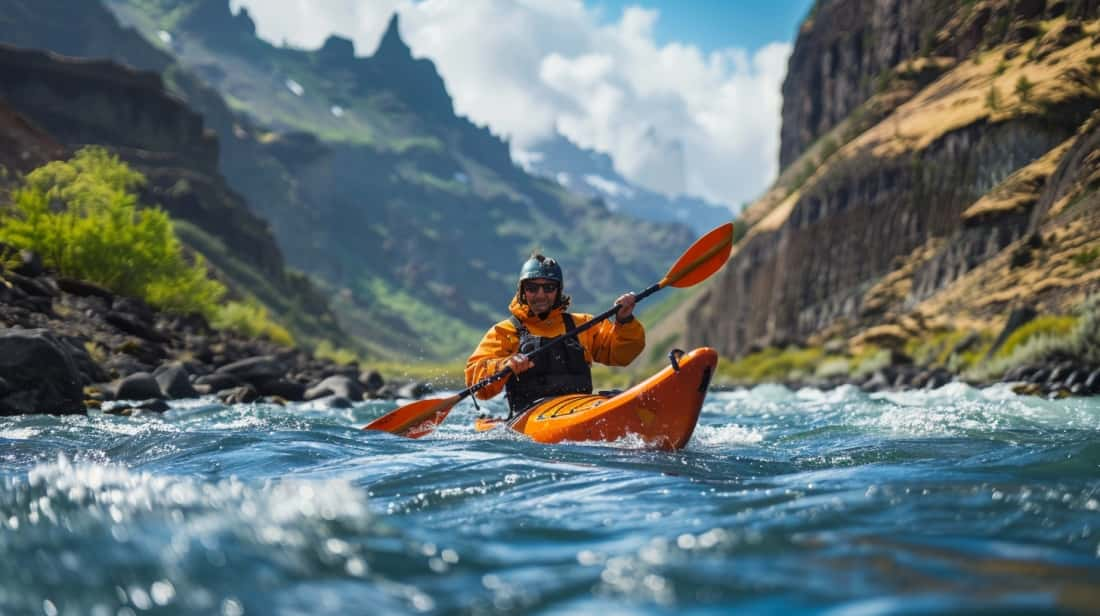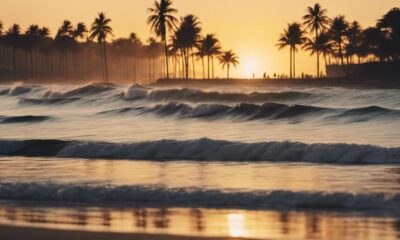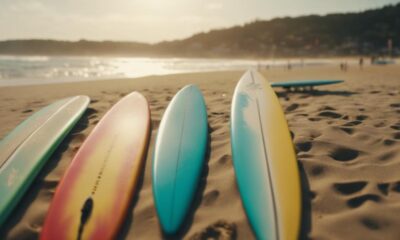Surfing Waves
Record Breaker: Largest Surfing Wave Ever
An astonishing feat by Sebastian Steudtner at Nazaré leaves surfers wondering: what does it take to conquer the world's largest wave?
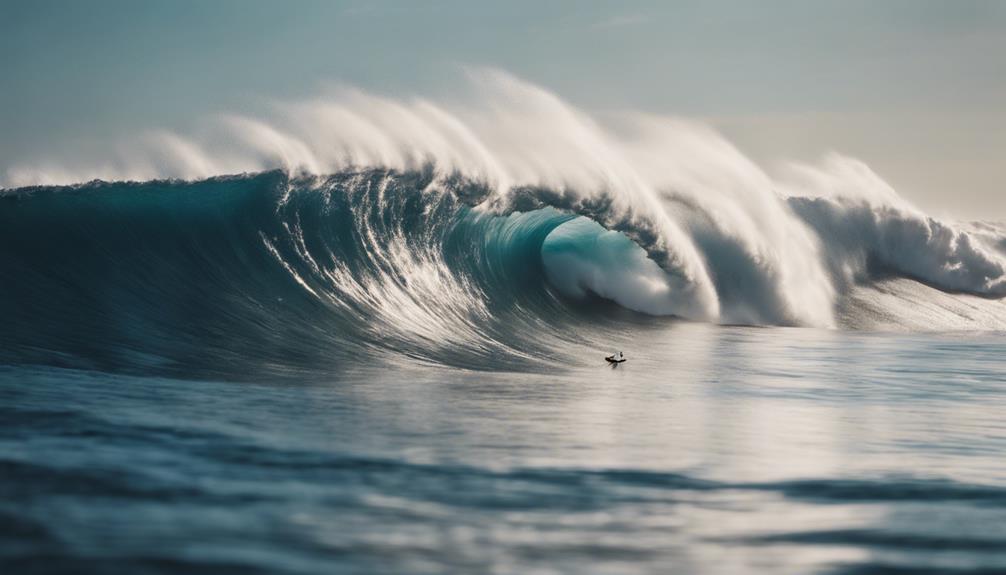
You're looking at the record for the largest surfing wave ever ridden, and it's held by Sebastian Steudtner. He conquered a massive wave measuring 26.21 meters (86 feet) at Praia do Norte, Nazaré, Portugal, on October 29, 2020. This incredible achievement surpassed the previous record of 24.4 meters (80 feet), set by Rodrigo Koxa in 2017. Steudtner's ride was officially recognized by Guinness World Records on May 24, 2022. The underwater topography of Nazaré Canyon creates such giant swells, luring surfers worldwide. There's more to this story, including the training and community buzz surrounding big wave surfing.
Key Takeaways
- Sebastian Steudtner holds the record for the largest surfing wave ever, measuring 26.21 meters (86 feet), achieved on October 29, 2020 in Nazaré, Portugal.
- This record surpassed Rodrigo Koxa's previous record of 24.4 meters (80 feet) set on November 8, 2017.
- Wave measurements involved geometric corrections and video footage analysis for accurate height representation.
- Nazaré's unique underwater topography, specifically the Nazaré Canyon, creates massive swells ideal for big wave surfing.
Record-Breaking Wave Details
On October 29, 2020, Sebastian Steudtner rode an astonishing wave measuring 26.21 meters (86 feet) at Praia do Norte in Nazaré, Portugal, setting a new world record. This incredible feat made him the holder of the largest wave surfed, surpassing the previous record of 24.4 meters (80 feet) set by Rodrigo Koxa on November 8, 2017.
The announcement from Guinness World Records came nearly two years later, on May 24, 2022, solidifying Steudtner's achievement in the world of big wave surfing.
The process of measuring the wave involved intricate geometric corrections and the analysis of video footage featuring known objects for accuracy. This meticulous approach guarantees that such records maintain their credibility and precision.
The unique underwater topography of Nazaré, particularly the Nazaré Canyon, plays an essential role in generating these massive swells, making it a favored spot for surf enthusiasts.
Steudtner's record-breaking ride not only showcases his exceptional skills but also highlights the incredible natural conditions that allow for such monumental waves to form at Praia do Norte.
Sebastian Steudtner's Journey
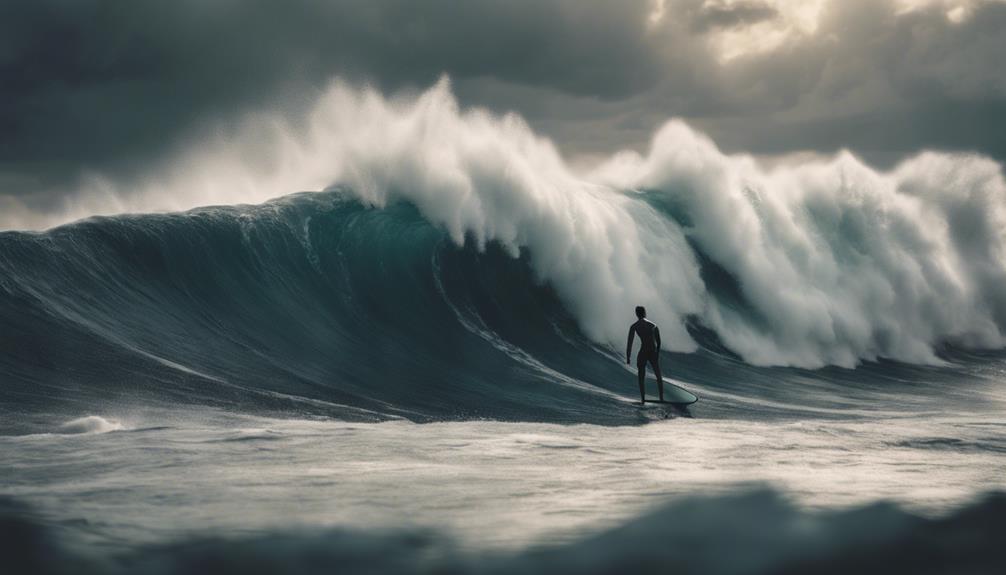
Sebastian Steudtner's journey to becoming a world record holder began when he moved to Hawaii at just 16, determined to carve out a place for himself in the competitive world of surfing. From the start, he faced skepticism and a lack of support, but his passion for the sport drove him forward.
Over the years, he honed his skills, culminating in his record-setting ride on October 29, 2020, where he surfed the largest wave at 26.21 meters (86 feet) at Praia do Norte in Nazaré, Portugal.
Key elements of Sebastian's success include:
- Year-long physical training to build strength and endurance
- Mental readiness to face the challenges of big wave surfing
- Persistence in overcoming initial doubts and obstacles
- Continuous learning and adaptation within the surfing community
His achievement wasn't confirmed by Guinness World Records until May 24, 2022, surpassing the previous record by 6 feet.
Sebastian Steudtner's surfing career is a demonstration of dedication and resilience, inspiring surfers around the world to chase their own dreams.
Training for Big Waves
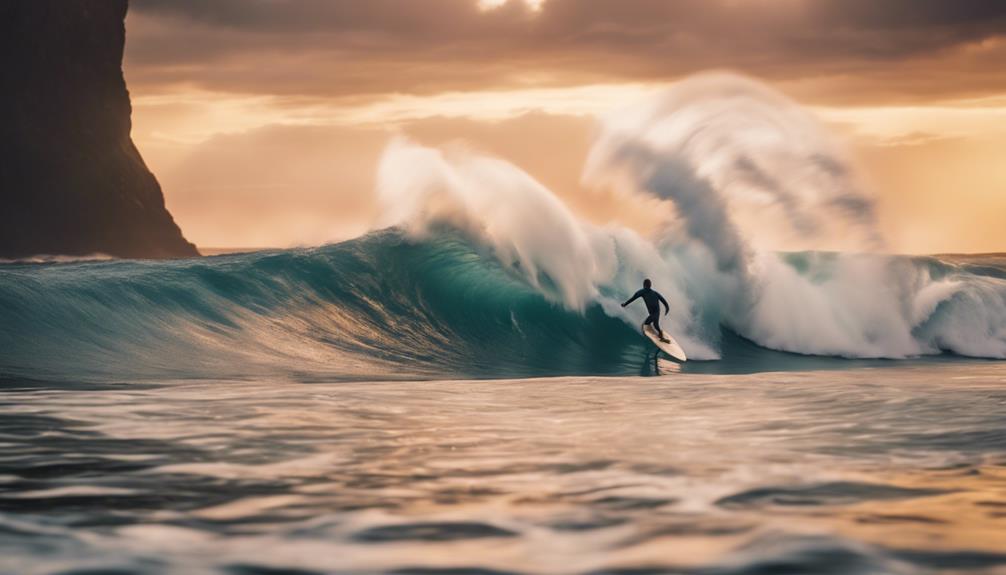
Training for big waves demands intense physical and mental preparation, ensuring surfers are ready to tackle the ocean's most formidable challenges. As a big wave surfer, you'll need to focus on enhancing your strength and endurance while honing your mental resilience. It's not just about your individual skills; teamwork plays a vital role. Collaborating with fellow surfers allows you to refine equipment and safety processes.
Here's a quick overview of essential training components:
| Focus Area | Description | Techniques Used |
|---|---|---|
| Physical Training | Build strength and endurance | Weightlifting, cardio workouts |
| Mental Preparation | Develop focus and visualization | Meditation, mental rehearsal |
| Teamwork | Enhance collaboration and safety | Partner drills, shared feedback |
| Performance Review | Analyze past performances | Video analysis, feedback sessions |
| Technique Refinement | Adapt strategies for big waves | Simulation training, peer coaching |
Measurement Techniques Explained
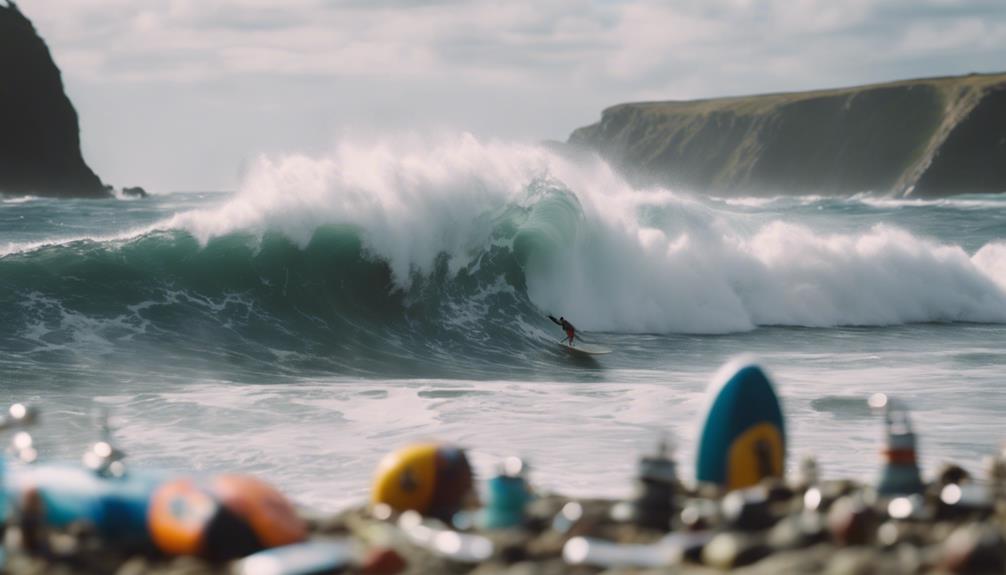
Measuring wave heights accurately involves applying geometric corrections to video footage and using known reference objects for precise conversions. This measurement process is vital for determining the true size of waves, especially in challenging environments like Nazaré Canyon, where the conditions can be extreme.
Here's how it works:
- Video Footage: High-quality recordings capture the wave's dynamics, allowing for detailed analysis.
- Geometric Corrections: These adjustments guarantee that perspective distortions are minimized, providing a true representation of the wave height.
- Reference Objects: By incorporating known objects, such as surfers or buoys, you can convert pixel measurements from videos into actual feet.
- Verification Techniques: The process involves meticulous checks to confirm the accuracy of the calculated heights.
Future Record Aspirations
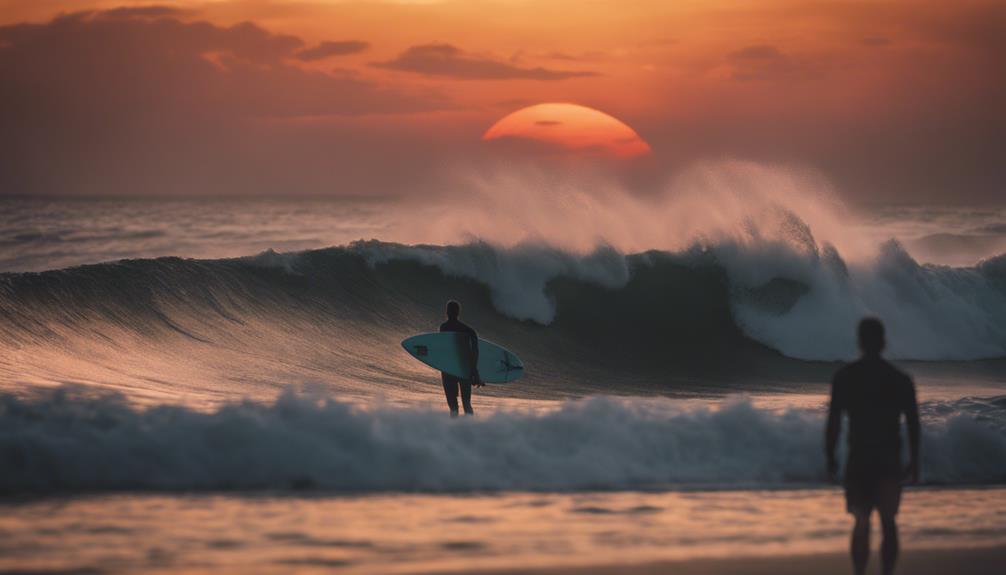
As big wave surfers set their sights on breaking records, the dream of conquering a 100-foot wave looms on the horizon. With Sebastian Steudtner's recent achievement of surfing the biggest wave ever at 86 feet in Nazaré, you can feel the excitement building among big wave surfers. The community is buzzing with speculation around Lucas Chumbo Chianca's massive ride in February 2023, which many believe could lead to a new world record.
Advancements in surfing technology are essential to these future record aspirations. Improved surfboard designs and enhanced safety gear are helping surfers push their limits further than ever before. The Nazaré Surf Rescue Association, co-founded by Steudtner, emphasizes safety protocols to guarantee that as surfers chase these monumental waves, they do so with the necessary precautions in place.
As you look ahead, it's clear that big wave surfers aren't just aiming for personal records but are collectively focused on what it takes to ride a 100-foot wave. The journey toward this new world record is filled with ambition and innovation, promising an exhilarating future for the sport of big wave surfing.
Community Reactions and Buzz

You can't help but feel the excitement rippling through the surfing community after Lucas Chumbo Chianca's incredible ride in Nazaré.
Social media's alive with fans and surfers analyzing every angle of his performance, igniting conversations about what this could mean for future records.
Everyone's buzzing about the possibility of pushing the limits of big wave surfing even further.
Excitement Among Surfers
Surfers are buzzing with excitement over Lucas Chumbo Chianca's incredible wave ride in Nazaré, sparking hopes for a new world record. This monumental event has ignited the competitive spirit within the surfing community, as everyone reflects on the potential implications for big wave surfing.
Here's what you need to know about the excitement surrounding Chumbo's ride:
- Record-Breaking Potential: Chumbo's performance could challenge existing world records, pushing the limits of what's possible in surfing.
- Inspiration for Others: French surfer Justine Dupont emphasized how Chumbo's ride might motivate fellow surfers to tackle bigger waves.
- Ultimate Aspirations: Many in the community, including renowned big-wave surfer Jose Carlos, aspire to ride a 100-foot wave, showcasing their ambitious goals.
- Community Engagement: Social media is buzzing with discussions, analyses, and highlights of Chumbo's ride, reflecting the enthusiasm shared by surfers worldwide.
The excitement is palpable, and the surfing world is keenly awaiting official announcements!
Social Media Reactions
Social media has exploded with reactions to Lucas Chumbo Chianca's monumental wave, as the surfing community enthusiastically discusses the possibility of breaking records and inspiring future endeavors.
Many surfers are speculating whether Chumbo's massive ride could surpass Sebastian Steudtner's current Guinness record of 86 feet. French surfer Justine Dupont highlighted the significance of Chumbo's wave, igniting further conversations across platforms like Instagram and Twitter.
Surfers are sharing clips and analyses of Chumbo's impressive feat, generating a buzz around potential new record claims. Big-wave surfer Jose Carlos even fueled the excitement by referencing the community's ambition to ride a 100-foot wave, indicating that aspirations are only growing.
As anticipation builds for official announcements about Chumbo's ride status, the excitement is palpable. Experts and fellow surfers are keenly awaiting verification and confirmation from the Guinness World Records.
This moment in surfing history not only showcases Chumbo's incredible talent but also unites the community in a shared passion for pushing boundaries and achieving the extraordinary in the domain of big waves.
Related Surfing Events

The excitement surrounding big wave surfing is amplified by prestigious events like the Red Bull Big Wave Awards, which celebrate remarkable achievements in the sport. These events not only showcase the bravery of surfers but also highlight the impressive feats they accomplish.
For instance, Sebastian Steudtner claimed the Biggest Tow Award in 2021 for riding the Largest Wave Ever Surfed at 86 feet. Justine Dupont also made history in February 2023 with her stunning 70.5-foot wave at Nazaré, further elevating women's roles in big wave competitions.
Here's a quick look at some key surfing events related to big wave surfing:
- Red Bull Big Wave Awards: Honors surfers for their incredible achievements, including the biggest waves ever surfed.
- World Surf League (WSL) Championship Tour: Features elite surfers from around the world, pushing for new records.
- Red Bull Magnitude: A thrilling event that showcases the best in big wave surfing.
- Biggest Paddle Wave Category: Recognizes surfers who ride massive waves without assistance.
These events foster competition and excitement in the big wave surfing community.
Notable Surfing Records

When it comes to notable surfing records, there's a lot to unpack.
You'll learn about the current record holder, explore historical achievements, and consider future possibilities that could reshape the sport.
Each wave tells a story of triumph and ambition, capturing the essence of big wave surfing.
Current Record Holder
Sebastian Steudtner's remarkable achievement of surfing an 86-foot wave at Praia do Norte in Nazaré, Portugal, currently sets the Guinness World Record for the largest wave ever ridden. This incredible feat took place on October 29, 2020, and it surpassed the previous record held by Rodrigo Koxa, who rode an 80-foot wave at the same location in 2017.
Here are some notable milestones in big wave surfing:
- Sebastian Steudtner: 86 feet (26.2 meters) – October 29, 2020
- Rodrigo Koxa: 80 feet (24.4 meters) – November 8, 2017
- Garrett McNamara: 78 feet (23.8 meters) – November 1, 2011
- Maya Gabeira: 73.5 feet (22.4 meters) – February 11, 2020, first woman over 70 feet
Steudtner's record stands as a demonstration of the daring spirit and skill of big wave surfers, showcasing the extreme conditions they tackle to push the limits of their sport.
Historical Achievements Overview
Big wave surfing has a rich history marked by extraordinary accomplishments that showcase the bravery and skill of surfers pushing the limits of their sport.
One of the most notable achievements came from Sebastian Steudtner, who set the world record for the largest wave surfed at an astonishing 86 feet (26.2 meters) on October 29, 2020, at Praia do Norte, Nazaré, Portugal. This historic ride surpassed the previous record held by Rodrigo Koxa, who rode an 80-foot (24.4 meters) wave at the same location in 2017.
Garrett McNamara played a pivotal role in popularizing Nazaré as a premier big wave surfing destination with his impressive 78-foot (23.8 meters) ride in 2011. The area's unique underwater canyon, Canhão da Nazaré, contributes to its potential for massive waves, often exceeding 100 feet in ideal conditions.
Maya Gabeira made waves of her own by becoming the first woman to surf a wave over 70 feet, achieving a remarkable 73.5-foot (22.4 meters) ride on February 11, 2020. These achievements not only highlight individual talent but also the growing recognition of women's contributions to the sport.
Future Record Possibilities
The potential for future record-breaking waves remains tantalizing, especially with recent rides sparking excitement and anticipation among the surfing community. The current record for the Biggest Wave, set by Sebastian Steudtner who surfed an 86-foot wave in October 2020, may soon be challenged. Lucas Chumbo Chianca's impressive wave ride on February 24, 2023, hinted at a potential new record, although it awaits formal verification.
As surfers continue to push their limits, several factors will play a significant role in future record attempts:
- Advances in surfing technology enhance performance and safety.
- The Nazaré Canyon's unique underwater topography generates massive waves.
- Collaboration among elite surfers fosters knowledge sharing and skill development.
- Increased interest in surfing from coastal fishing villages boosts local support.
With these elements in play, the world of big wave surfing is on the brink of new milestones. So, keep an eye on the ocean; you never know when the next huge wave might roll in, ready to break records and redefine what's possible in this exhilarating sport.
Frequently Asked Questions
What Is the Biggest Surfing Wave in History?
The biggest surfing wave in history measures an astonishing 26.21 meters. It was surfed in Nazaré, Portugal, where unique underwater formations create massive waves, attracting thrill-seekers enthusiastic for an unforgettable challenge.
Has a 100 Foot Wave Been Surfed?
You'd think riding a 100-foot wave's like catching a unicorn, right? While claims swirl, none have officially surfed that beast. So, for now, let's stick to the 86-foot wave, it's still a thrill!
Did Someone Surf a 115 Foot Wave?
No, no one's officially surfed a 115-foot wave yet. While some surfers claim to have ridden massive waves, those records remain unverified. The surfing community's still buzzing about the possibility, though!
What Is the Biggest Wave Breaker in the World?
Imagine a colossal wall of water crashing down like thunder. The biggest wave breakers in the world, like those at Nazaré, Portugal, harness nature's fury, creating breathtaking surf conditions that challenge even the most skilled surfers.
What Makes the Largest Surfing Wave Ever Different from Other Record-Breaking Waves?
The biggest surfing waves ever are unique in their sheer magnitude and power. Unlike other record-breaking waves, these massive swells provide an unparalleled challenge for skilled surfers, requiring advanced techniques and courage to conquer. The sheer size of these waves sets them apart from all others, making them a true feat for the most daring surfers.
Conclusion
As you ride the wave of excitement from Sebastian Steudtner's incredible feat, remember that the ocean's power is as timeless as a classic vinyl record.
His journey inspires you to chase your own dreams, no matter how big.
With the surfing community buzzing and new technologies advancing, who knows what record will be broken next?
So, grab your board, embrace the thrill, and keep your eyes peeled for the next wave of greatness waiting just around the corner!
Surfing Waves
Dive Into Adventure: 7 Unique Water-Based Activities Unveiled

Are you ready to make a splash beyond traditional water parks? Discover a world of thrilling aquatic adventures that will get your adrenaline pumping and create unforgettable memories. From underwater museums to bioluminescent bay kayaking, we’ve compiled a list of seven unique water-based activities that will quench your thirst for excitement.
1. Underwater Exploration: Scuba Diving and Snorkeling
Dive into the depths of the ocean and explore vibrant coral reefs teeming with marine life. Whether you’re a beginner or an experienced diver, there’s an underwater adventure waiting for you.
Best Locations for Beginners:
- Key Largo, Florida
- Cozumel, Mexico
- Great Barrier Reef, Australia
Advanced Diving Experiences:
- Blue Hole, Belize
- Silfra Fissure, Iceland
- Palau, Micronesia
Before embarking on your underwater adventure, make sure to get proper training and certification. Always prioritize safety and follow local guidelines.
2. Thrilling Water Sports: Beyond the Basics
Take your water adventures to the next level with these exhilarating sports that combine skill, balance, and adrenaline.

Kiteboarding and Windsurfing:
Harness the power of wind and waves as you glide across the water’s surface. Popular destinations include:
- Maui, Hawaii
- Tarifa, Spain
- Cabarete, Dominican Republic
Whitewater Rafting and Kayaking:
Navigate through rushing rapids and experience the thrill of conquering wild rivers. Top locations include:
- Colorado River, Grand Canyon
- Zambezi River, Zimbabwe
- Futaleufú River, Chile
Popular Water Sports Destinations
3. Unique Aquatic Experiences
Dive into these one-of-a-kind water-based activities that combine art, nature, and adventure.
Underwater Museums and Sculpture Parks:
Explore submerged art installations that double as artificial reefs, supporting marine life while providing a unique diving experience.
- MUSA (Museo Subacuático de Arte), Mexico
- Molinere Underwater Sculpture Park, Grenada
- The Underwater Museum of Marseille, France
Bioluminescent Bay Kayaking:
Paddle through waters that glow with bioluminescent microorganisms, creating a magical nighttime experience.
- Mosquito Bay, Vieques, Puerto Rico
- Luminous Lagoon, Jamaica
- Jervis Bay, Australia
Ice Diving in Frozen Lakes:
For the truly adventurous, explore the serene underwater world of frozen lakes and witness unique ice formations.
- Lake Baikal, Russia
- Plansee, Austria
- Morrison’s Quarry, Canada
Underwater Museums
MUSA in Mexico has over 500 sculptures, covering 420,000 sq ft
Bioluminescent Bay Kayaking
Mosquito Bay’s organisms produce 1,000 times more light than a firefly
Ice Diving in Frozen Lakes
Lake Baikal’s ice diving season: January to April, -2°C to 4°C
4. Eco-Friendly Water Adventures
Combine your love for water activities with environmental conservation efforts.
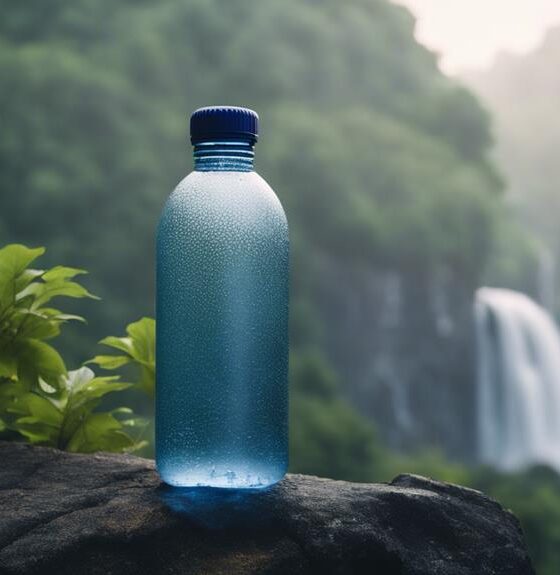
Swimming with Marine Life Responsibly:
Interact with gentle giants of the sea while following responsible wildlife tourism practices.
- Whale sharks in Isla Holbox, Mexico
- Manatees in Crystal River, Florida
- Dolphins in Kaikoura, New Zealand
Coral Reef Restoration Programs:
Participate in hands-on conservation efforts to protect and restore fragile coral ecosystems.
- Coral Restoration Foundation, Florida Keys
- Great Barrier Reef Marine Park Authority, Australia
- Gili Eco Trust, Indonesia
Eco-Friendly Water Adventure Tips
- Reduce Plastic Waste: 8 million tons of plastic waste enter oceans yearly. Bring reusable water bottles and gear.
- Respect Marine Life: 75% of coral reefs are threatened. Never touch or stand on coral reefs.
- Conserve Water: Average person uses 80-100 gallons daily. Take shorter showers and turn off taps when not in use.
- Support Sustainable Tourism: Choose tour operators with eco-certifications and responsible practices.
- Learn About Local Ecosystems: 75% of fish populations are overfished. Support local conservation efforts and education programs.
Planning Your Unique Water-Based Adventure
Before diving into your next aquatic adventure, consider these essential tips:
- Research the best seasons for your chosen activity
- Invest in proper gear and equipment
- Choose reputable tour operators and guides
- Consider travel insurance that covers water-based activities
- Respect local customs and environmental regulations
For more water park tips and guides, visit All Waterparks’ Water Park Tips & Guides section.
What Water-Based Activities in Queenstown Can I Try With the Best Jet Boat?
When in Queenstown, don’t miss out on the exhilarating water-based activities. Take a ride on the best jet boat in queenstown and experience the thrill of speeding across the water, maneuvering through narrow canyons, and performing adrenaline-pumping spins and turns. It’s a must-try for adventure seekers!
Conclusion: Dive Into Your Next Adventure
From exploring underwater museums to kayaking in bioluminescent bays, these unique water-based activities offer unforgettable experiences for adventure seekers. Whether you’re a seasoned water enthusiast or looking to dip your toes into something new, there’s an aquatic adventure waiting for you.
Remember to always prioritize safety, respect the environment, and embrace the thrill of discovering new water-based activities. So grab your swimsuit, pack your sense of adventure, and get ready to make a splash in ways you never imagined!
For more inspiration on water-based fun, check out All Waterparks’ Best Water Parks and Indoor Water Parks sections. The world of water adventures awaits – dive in and explore!
Surfing Waves
Iconic Breaks: Most Famous Surfing Waves
Adventure awaits as you explore the world's most iconic surfing breaks, each promising unforgettable challenges and breathtaking experiences that will leave you yearning for more.

If you're chasing the thrill of surfing iconic waves, you can't miss Pipeline in Oahu, known for its powerful, hollow barrels. Teahupo'o in Tahiti challenges even the most seasoned surfers with its massive waves crashing over sharp reefs. Mavericks in California delivers bone-chilling, towering swells that draw the best competitors. Then there's Nazaré in Portugal, famous for monstrous waves that can exceed 100 feet! Each spot offers distinct characteristics that define the surfing experience. By exploring these legendary breaks, you'll discover what makes each unique and the culture that surrounds them.
Key Takeaways
- Pipeline in Oahu is renowned for its powerful, hollow waves and hosts the prestigious Pipeline Masters competition every December.
- Teahupo'o in Tahiti is famous for being the heaviest wave, breaking over sharp coral reefs and often exceeding 30 feet.
- Mavericks in California features cold, powerful waves ranging from 25 to 50 feet and is home to elite surf competitions.
- Nazaré in Portugal produces some of the largest waves globally, reaching up to 100 feet due to its unique underwater canyon.
Overview of Iconic Surf Breaks
When it comes to iconic surf breaks, you'll find some of the most thrilling waves in the world, each offering unique challenges and experiences for surfers.
Pipeline in Oahu, Hawaii, is a must-visit for any surfer. Known for its powerful, hollow waves, it hosts the prestigious Pipeline Masters competition every December, attracting elite surfers enthusiastic to conquer its famous barrels.
Teahupo'o in Tahiti is another beast altogether, recognized as one of the heaviest waves globally. The wave breaks over a razor-sharp coral reef, producing waves that can exceed 30 feet, making it a magnet for big-wave surfers.
Mavericks, near Half Moon Bay, California, is infamous for its cold, powerful waves that can reach heights between 25 and 50 feet during winter swells. This surf break is home to the Mavericks Surf Contest, where only the bravest compete.
In Nazaré, Portugal, Praia do Norte produces some of the largest waves in the world, sometimes reaching up to 100 feet, thanks to its unique underwater canyon.
Top Big Wave Surfing Locations

Exploring the top big wave surfing locations reveals some of the most exhilarating and challenging spots that every adrenaline-seeking surfer should experience.
Nazaré in Portugal is famous for its colossal waves, reaching up to 100 feet, thanks to its unique underwater canyon. If you're looking for powerful swells, Jaws (Peahi) in Maui, Hawaii, is a must-visit, with waves exceeding 60 feet during winter swells, especially since the rise of tow surfing in the 1990s.
Teahupo'o in Tahiti holds the title of the 'Heaviest Wave in the World,' featuring thick, hollow waves over sharp reefs, often exceeding 30 feet. Mavericks, located near Half Moon Bay in California, is known for cold, powerful waves reaching 25 to 50 feet, making it one of the best surf spots for elite surfers and hosting thrilling competitions.
Finally, don't overlook Cortes Bank, a submerged island off California's coast, infamous for treacherous conditions and record-breaking waves that can soar over 75 feet.
These top big wave surfing locations are where you'll find some of the most famous waves on the planet.
Unique Features of Each Break
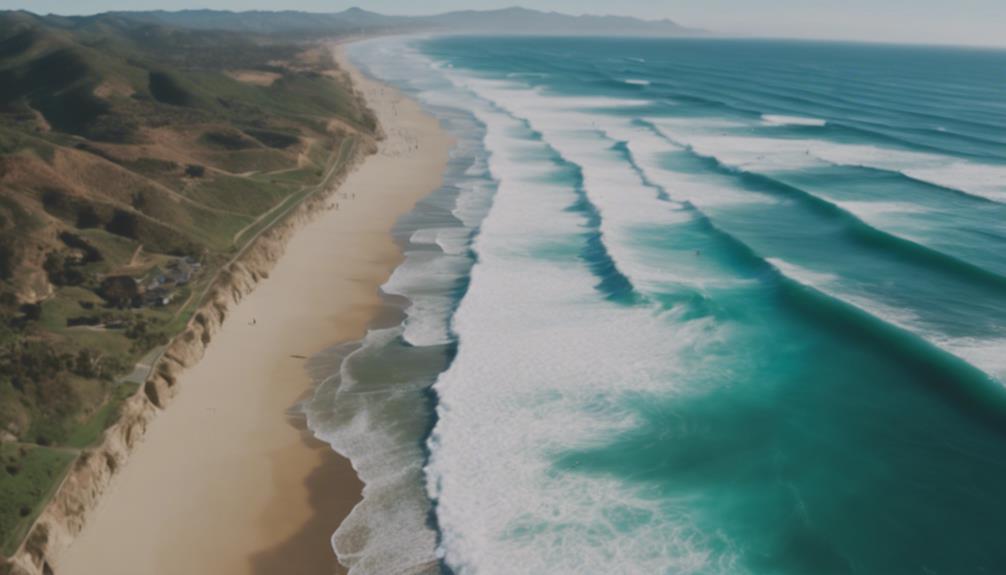
What makes each surfing break unique lies in its distinct wave characteristics and the challenges they present to surfers.
Teahupo'o, known as 'The Heaviest Wave in the World,' features thick, heavy waves that crash over a shallow reef, making it a formidable spot for even seasoned surfers.
On Maui, Jaws delivers powerful waves that can exceed 60 feet, drawing elite surfers enthusiastic to tackle its fierce conditions.
In Nazaré, Portugal, the unique underwater canyon enhances wave formations, allowing for some of the largest surfable waves in the world, sometimes reaching up to 100 feet.
Mavericks in California showcases cold, powerful waves that challenge surfers with heights of 25 to 50 feet, often hosting the intense Mavericks Surf Contest.
Lastly, Pipeline in Oahu, Hawaii, stands out as the ultimate surfing destination, featuring hollow waves that create perfect barrels. This spot not only attracts competitive surfers but also holds a cherished place in the surf community.
Each of these breaks offers unique features that make them iconic, inviting surfers to confront their power and embrace the thrill.
Safety and Preparation Essentials

To tackle the challenges of big wave surfing safely, it's essential to prepare thoroughly and equip yourself with the right gear and knowledge. Big-wave surfer Mark Foo emphasized the importance of preparation for big wave surfing, which includes selecting appropriate gear like a shortboard, wetsuit, and safety equipment.
Given the extreme conditions you'll face, having a jet ski or boat support is critical, especially at offshore breaks, to assist in paddling into the waves and guaranteeing a safe return.
You also need to develop strong decision-making skills regarding whether to paddle into waves or tow into them, as this can greatly impact your safety and performance. Continuous training and mental preparation are crucial for managing the physical and emotional toll of surfing in high-risk environments.
Familiarizing yourself with safety protocols, such as buddy systems and emergency procedures, will help mitigate risks associated with potential injuries or fatalities.
Before heading to your chosen surfing spot, make sure you've honed these skills and have the right support system in place. Being prepared isn't just about gear; it's about being ready for whatever the ocean throws your way.
Surfing Culture and Community Impact

Surfing culture thrives on the connections among surfers, shaping local identities and fostering a deep sense of community wherever waves break. Each iconic break, from Pipeline to Teahupo'o, embodies unique traditions, such as the Aloha spirit in Hawaii or California's laid-back vibe. Surf schools play an essential role, making surfing accessible to newcomers while boosting local economies through tourism.
Surfing events, like the Eddie Aikau Competition at Waimea Bay, highlight the camaraderie among local communities and international competitors. These gatherings celebrate not only the sport but also the shared passion that unites surfers of all backgrounds. The emotional highs and lows of these events emphasize the importance of respect for the ocean and each other within the professional culture.
As surfing continues to evolve, its community impact remains significant. The stories and experiences shared at iconic breaks create bonds that transcend borders, inspiring new generations to embrace the ocean. By fostering a culture rooted in respect and connection, surfing nurtures a vibrant community that thrives on the waves, ensuring that the spirit of the sport lives on for years to come.
Frequently Asked Questions
What Is the Most Famous Surf Break?
When you think about the most famous surf break, Pipeline in Hawaii often comes to mind. Its incredible waves, thrilling challenges, and vibrant surf culture draw surfers and spectators from around the world year after year.
What Is the Name of the Legendary Surf Break?
You might call it Pipeline, a legendary surf break known for its powerful waves. Surfers flock to its shores, ready to tackle the thrilling challenges it presents, making it an unforgettable destination for wave riders.
Where Is the Biggest Surf Break in the World?
Did you know waves at Praia do Norte in Nazaré can reach heights of up to 100 feet? This stunning surf break in Portugal is recognized as the biggest in the world, attracting thrill-seeking surfers globally.
What Is the Famous Surf Break in Spain?
If you're looking for famous surf breaks in Spain, Mundaka's your spot. Its heavy left-hand tube and powerful waves attract elite surfers, especially during autumn swells, making it a must-visit for any surf enthusiast.
Are the Most Famous Surfing Waves Also the Longest in the World?
The longest surfing waves worldwide are not necessarily the most famous. While spots like Waimea Bay and Pipeline in Hawaii are renowned for their epic waves, lesser-known locations like Chicama in Peru and Coxos in Portugal offer some of the longest rides in the world.
Conclusion
In conclusion, surfing's spectacular spots serve up thrilling challenges and unforgettable experiences.
Whether you're chasing colossal waves or craving cozy breaks, each iconic location offers its own charm and community.
So, grab your gear, gather your gang, and get ready to ride the rippling rhythm of the sea.
Embrace the essence of these enchanting waves, and let the ocean's endless energy elevate your surfing adventure to exhilarating heights!
Surfing Waves
Global Danger: Most Dangerous Surfing Waves in the World
You won't believe the treacherous surfing waves that await in the world's most dangerous spots; discover the risks that could change your life forever.

If you're looking for the most dangerous surfing waves in the world, you should be aware of spots like Pipeline, Teahupoo, and Mavericks. Pipeline is infamous for its shallow reefs and has caused seven fatalities since 1989. Teahupoo's fierce waves challenge even experts, while Mavericks draws thrill-seekers with its colossal swells. Puerto Escondido's heavy surf can be deadly, and Waimea Bay has a tragic history of accidents. Each location presents unique risks, and it's vital to respect the ocean. You may find that there's more to uncover about these thrilling but perilous surfing spots.
Key Takeaways
- Dangerous surfing waves like Pipeline, Teahupoo, and Mavericks present serious risks, including fatalities and severe injuries due to their extreme conditions.
- Pipeline, Hawaii is known as the deadliest wave, with seven recorded fatalities since 1989, primarily due to shallow reefs and strong currents.
- Teahupoo in Tahiti features powerful waves amplified by a reef structure, resulting in five fatalities since 2000, highlighting the importance of respect for the ocean.
- Puerto Escondido, Mexico is notorious for heavy surf and strong currents, posing life-threatening risks even to experienced surfers, with recent fatalities reported.
Overview of Dangerous Surfing Waves
Dangerous surfing waves pose serious risks to surfers, challenging even the most skilled riders with their powerful forces and unpredictable nature. Big wave surfing attracts thrill-seekers who often underestimate the dangers that come with these monstrous waves. Locations like Teahupoo in Tahiti and Mavericks in California showcase extreme wave dynamics that can lead to significant risk of injury.
Surfers face perilous conditions, from heavy waves crashing onto unforgiving reefs to strong currents that can pull even experienced riders underwater. Each wave presents a unique challenge, and the stakes are high. The risk of injury is ever-present, with wipeouts resulting in serious consequences, including drowning or severe trauma.
As you navigate these dangerous waves, it's crucial to respect the ocean's power and understand the inherent risks involved. Areas like Puerto Escondido and Dungeons in South Africa are notorious for their heavy surf, adding another layer of danger. Knowing the conditions and preparing adequately can make a difference, but no amount of skill can fully eliminate the risks associated with big wave surfing.
Always prioritize safety and approach these waves with caution.
Pipeline, Hawaii: The Deadliest Wave

When you think of surfing dangers, Pipeline in Hawaii stands out with its deadly reputation.
With seven fatalities since 1989 and numerous incidents like Evan Geiselman's close call, the risks are real.
Surfers need to be aware of the shallow reefs and strong currents that make this wave both a challenge and a threat.
Notable Fatalities and Incidents
Pipeline, Hawaii, stands notorious for its treacherous waves, having claimed seven lives since 1989. This location is infamous for its notable fatalities, including Andy Chuda in 1989 and Travis Mussleman in 2000. Both surfers fell victim to the dangers posed by Pipeline's powerful waves, which can easily overwhelm even the most experienced surfers.
The risks at Pipeline are amplified by its shallow reef, which lies just beneath the surface. During big swells, the waves crash violently, creating a perilous environment for those attempting to ride them. The sheer force of these tubular formations can lead to severe injuries or worse. Many surfers underestimate the wave's power, believing that skill alone will keep them safe.
Despite the tragic history, surfers continue flocking to Pipeline, drawn by its challenge and allure. The beach remains a testing ground where ambition and danger collide. You must respect these waters and acknowledge the risks involved, as many have learned too late that Pipeline isn't just a surfing spot—it's a reflection of nature's might. Always prioritize safety and be aware of the inherent dangers when tackling this iconic wave.
Surfer Rescues and Risks
Surfers face immense risks at Pipeline, where the powerful waves and shallow reefs can turn a thrilling ride into a life-threatening situation in an instant. Known as the deadliest wave globally, Pipeline has recorded seven fatalities since 1989, underscoring the inherent danger of surfing here. While the adrenaline rush is undeniable, the risks are real.
Here are three key dangers surfers encounter at Pipeline:
- Wipeouts: Surfers often hit the ocean bed during wipeouts, risking severe injuries.
- Coral Reefs: The shallow water and sharp reefs can lead to dangerous impacts, making rescues more essential.
- High-Impact Waves: The wave's tubular formation creates a powerful force that can easily overwhelm even experienced surfers.
Notable rescues, like Evan Geiselman's in December 2015, highlight the urgent need for safety measures.
Despite the high stakes, surfers are drawn to Pipeline's allure, showcasing their courage and determination. However, it's vital to prioritize awareness and preparedness to navigate the dangers that come with surfing this iconic wave.
Teahupoo, Tahiti: A Reef Nightmare

When you think about Teahupoo, the sheer power and intensity of its waves immediately come to mind.
This spot has seen its share of notable incidents, reminding you of the real dangers lurking beneath the surface.
Local surfers know the risks all too well, employing unique practices to navigate this notorious reef safely.
Wave Power and Intensity
Teahupoo's waves release a ferocious intensity, transforming a seemingly calm ocean into a deadly spectacle that challenges even the most skilled surfers. Known for its heavy water, this spot embodies the concept of wave power like no other. Its unique reef structure amplifies swells, turning them into some of the most dangerous waves in the surfing world.
When you consider tackling Teahupoo, keep these factors in mind:
- Wave Dynamics: The semi-circular reef shape creates explosive breaks that can catch you off guard.
- Wipeouts: Even experienced surfers can face devastating wipeouts due to the shallow reef, leading to serious injuries.
- Fatal Risks: With five recorded deaths since 2000, the risks are real and demand respect.
Despite the dangers, the allure of riding such powerful waves attracts elite surfers from around the globe. However, knowing the intensity and risks involved is essential for anyone daring enough to challenge Teahupoo's infamous waves.
The combination of beauty and peril makes this location a true nightmare for the unprepared.
Notable Incidents and Rescues
The perilous nature of Teahupoo has led to numerous notable incidents and daring rescues, underscoring the wave's deadly reputation. Known as one of the most dangerous waves in the world, Teahupoo presents extreme risks that even seasoned surfers struggle to navigate.
Since 2000, five fatalities have occurred here, with Briece Taere's tragic death in 2001 serving as a stark reminder of the dangers associated with wipeouts into the shallow reef.
In 2015, Niccolo Porcella faced a near-fatal wipeout that was described as violently intense, illustrating the unpredictable nature of big-wave surfing at this location. Despite the waves rarely exceeding 10 feet, their power can be overwhelming, leading to significant injuries.
The unique dynamics of Teahupoo, where the semi-circular reef and ocean swell create waves that seem to 'suck up' the water, add to the challenge. Surfers tackling these extreme conditions often rely on quick-thinking friends and lifeguards for rescue, highlighting the camaraderie and risk inherent in big-wave surfing.
At Teahupoo, every ride can be both thrilling and perilous, demanding respect for the ocean's might.
Local Surfer Practices
Local surfers at Teahupoo embrace the challenge of its treacherous waves, honing their skills while maneuvering the risks of the shallow reef. The Tahitian surf community thrives on the adrenaline that comes with riding these dangerous waves, pushing themselves to master the extreme conditions.
Here's how they prepare:
- Training: Local surfers engage in rigorous physical training, focusing on strength and endurance to withstand the powerful swells.
- Equipment: They invest in specialized boards designed for the unique demands of Teahupoo, ensuring they can handle the intense forces of the waves.
- Safety Protocols: Surfers establish buddy systems and spotters to monitor each other, enhancing safety during rides and minimizing risks.
Despite the perilous nature of Teahupoo, the local surfers respect the ocean's power and understand the importance of preparation. They know that every session can be unpredictable, and the reef holds its dangers.
Puerto Escondido, Mexico: Heavy Risks

Puerto Escondido, Mexico, draws surfers with its breathtaking waves, but the dangers lurking beneath the surface can be life-threatening. Known for its heavy waves and unpredictable conditions, this spot has claimed the lives of surfers like Ron Cassidy, Noel Robinson, and Jay Adams in recent years. Even experienced surfers can find themselves overwhelmed by the powerful waves that crash onto the shores.
Despite improved lifeguard services, the risks remain high, especially during large swells. Surfers must be acutely aware of the dangerous conditions, as they can change rapidly. Mark Healey has voiced his doubts about surviving some of the most treacherous waves here, highlighting the unpredictability of the ocean.
Many surfers, including Makua Rothman, have shared harrowing tales of being pulled underwater by the sheer force of the waves. If you're planning to surf in Puerto Escondido, it's essential to respect the power of the ocean.
Only take on these heavy waves if you're well-prepared and experienced, because what looks like a thrilling ride can quickly turn into a perilous situation.
Waimea Bay, Hawaii: A History of Tragedy

Waimea Bay, Hawaii, has a long and tragic history that rivals the dangers found in Puerto Escondido, with its powerful waves claiming numerous lives since 1943.
Surfers flock to this iconic spot, drawn by its allure, but the risks are undeniable. Over the decades, several incidents have solidified Waimea Bay's reputation as one of the most dangerous surf locations in the world, leading to numerous fatalities.
Here are three notable tragedies that highlight the dangers:
- Dickie Cross (1943) – This surfer went missing while riding the treacherous waves, marking one of the first major incidents in Waimea's history.
- Donnie Solomon (1995) – His death reinforced the perilous nature of the bay, serving as a stark reminder for fellow surfers.
- Alec Ace Coole (2015) – He vanished while surfing, and despite extensive search efforts, he was never found, emphasizing the risks involved.
Surfers at Waimea Bay often embody a culture of caution, aware of the powerful waves and the tragic history that looms over this stunning yet dangerous surf haven.
Mavericks, California: Thrills and Perils

Mavericks in California is famous for its colossal waves, drawing surfers enthusiastic for both thrills and the inherent dangers that come with them. Waves can reach heights of 25 feet, with reports of some exceeding 80 feet under ideal conditions. The shallow reef creates dramatic impacts, making it a high-risk location.
Many professional surfers have faced the perilous conditions, and notable incidents have led to tragic losses, including the deaths of Mark Foo and Sion Milosky. Cold water and strong currents add to the hazards, prompting experts to call for better safety gear. You need to be aware of the risks before paddling out into these powerful waves.
Here's a quick overview of the dangers associated with Mavericks:
| Aspect | Details |
|---|---|
| Wave Height | Up to 80 feet |
| Water Temp | Cold water, around 50°F (10°C) |
| Risk Factors | Shallow reef, strong currents |
| Incidents | Deaths of Mark Foo and Sion Milosky |
| Surfer Type | Professional surfers |
Mavericks remains a thrilling yet dangerous challenge for those who seek the ultimate big wave experience.
Unique Waves Around the World

Beyond the challenges of Mavericks, surfers around the globe encounter a variety of unique waves that offer their own thrilling yet dangerous experiences. These waves aren't just any swells; they're some of the most dangerous waves on the planet. Here are three that stand out:
- Teahupoo, Tahiti: Known as the heaviest wave in the world, Teahupoo's semi-circular reef creates powerful swells that demand respect. Surfers have faced severe consequences here, with five recorded deaths since 2000.
- Dungeons, Cape Town, South Africa: With massive swells reaching up to 70 feet, Dungeons is notorious for its perilous conditions, including being situated in shark-infested waters. This adds an extra layer of danger for any daring surfer.
- Shipstern Bluff, Tasmania: Dubbed the 'wave at the end of the world,' Shipstern Bluff features complex formations and 'stair steps' that can reach 25 feet. It's a challenge even for the most experienced surfers.
Each of these unique waves presents not only excitement but also significant risks, making them unforgettable challenges for anyone brave enough to ride them.
Safety Measures for Surfers
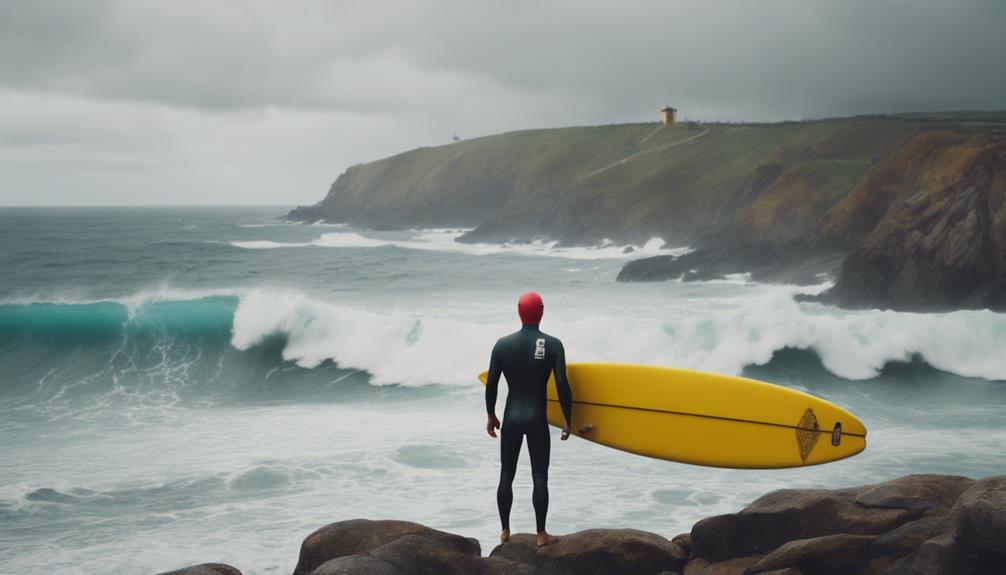
When hitting the waves, it's vital to prioritize safety by understanding your skill level and choosing appropriate surf spots. Always assess your personal skill level before paddling out; this helps reduce the risk of accidents. Opt for waves that match your abilities and avoid pushing your limits in dangerous conditions.
Familiarize yourself with local conditions by observing the beach and sea for at least 30 minutes before you enter the water. This observation will help you spot potential hazards like rip currents or submerged rocks. Make sure you have the appropriate safety equipment, such as a leash, life vest, and wetsuit, to protect yourself against injuries or cold water.
It's also critical to surf with a buddy or in a group. Having someone nearby can provide immediate assistance in case of emergencies.
Finally, stay informed about weather conditions. Changes in weather can greatly affect wave dynamics and safety, so always check forecasts before heading out.
Frequently Asked Questions
Where Is the Most Dangerous Wave to Surf?
If you're looking for the most dangerous wave to surf, Pipeline in Hawaii's your top choice. Its powerful waves and shallow reefs create a lethal mix, claiming lives and challenging even the bravest surfers.
Where Are the Roughest Waves in the World?
Did you know that waves at Mavericks can exceed 80 feet? When searching for the roughest waves in the world, consider Pipeline, Teahupoo, and Shipstern Bluff, each presenting unique and perilous challenges for surfers like you.
What Is the Most Dangerous Ocean for Waves?
The most dangerous ocean for waves is the Pacific. Its powerful swells and extreme conditions create notorious surf spots like Pipeline and Teahupoo, where surfers face significant risks and must respect the ocean's unpredictable nature.
Are the Waves at Nazaré Dangerous?
You wouldn't want to test the waters at Nazaré unless you're ready for a wild ride. The waves are exceptionally dangerous, with their massive heights and unpredictable conditions challenging even the most skilled surfers.
What Makes These Surfing Waves So Dangerous?
The deadliest surfing wave worldwide is known for its immense size and unpredictable behavior. Its powerful currents and sharp reef make it a formidable challenge for even the most experienced surfers. The wave’s reputation for causing severe injuries and even fatalities adds to its dangerous allure for adrenaline-seeking thrill-seekers.
Conclusion
Surfing isn't just a thrilling ride; it's a dance with danger.
As you paddle out to these infamous waves, remember that each swell holds its own unpredictable challenges.
From the treacherous reefs of Teahupoo to the monstrous barrels of Pipeline, respect the ocean's power.
Like a lion lurking in the grass, these waves can strike when you least expect it.
Stay informed, stay cautious, and let your passion for surfing guide you through the exhilarating waters of risk.
-
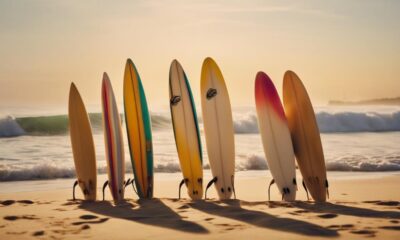
 Vetted5 months ago
Vetted5 months ago15 Best Surfboards of 2025: Ride the Waves Like a Pro
-

 Beach Body5 months ago
Beach Body5 months agoGlow Safely With Top Tanning Sunscreens
-

 Beach Body5 months ago
Beach Body5 months agoMaximize Your Glow Before Vacation
-

 Beach Body5 months ago
Beach Body5 months agoWhat Is the Beach Body Total Solution Pack? Find Out!
-

 Vetted5 months ago
Vetted5 months ago15 Best Surfing Pikachu V Cards That Every Collector Needs in Their Deck
-

 Vetted5 months ago
Vetted5 months ago14 Best Surfing Books to Inspire Your Next Wave Adventure
-
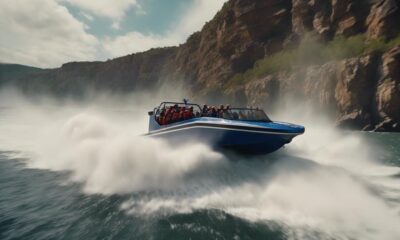
 Jet Boat5 months ago
Jet Boat5 months agoAre Jet Boats Dangerous? What You Need to Watch Out For!
-

 Surfing Waves5 months ago
Surfing Waves5 months agoDive Into Adventure: 7 Unique Water-Based Activities Unveiled


